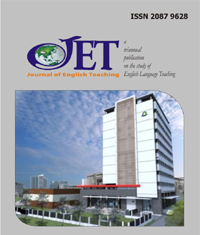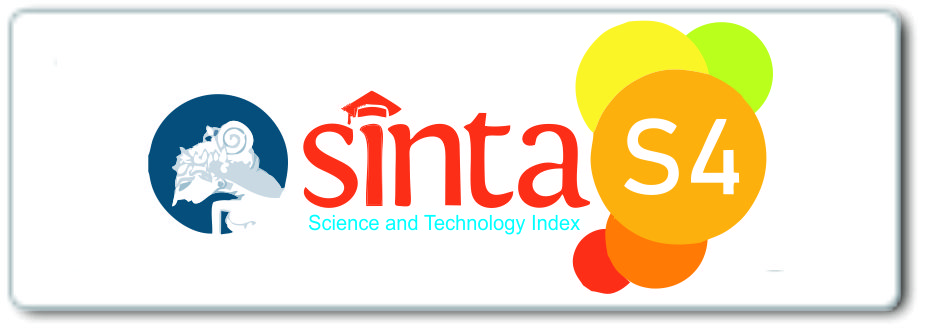Students' Perception of Using Storytelling Technique to Improve Speaking Performance at SMPN 143 Jakarta Utara
DOI:
https://doi.org/10.33541/jet.v8i2.4063Keywords:
EFL, speaking, storytellingAbstract
Speaking is an essential skill to master in every foreign language learning. It even can be used to measure a foreign language learner’s success. However, learning to speak a foreign language, particularly English, is extremely difficult for beginners and to help them using storytelling is highly recommended (Haven, 2000; Caine, et al., 2005). However, learners’ perception is one of the most important success factors in any learning technique, including storytelling, because they are among the main stakeholders of learning. This study aims at exploring students’ perception of storytelling techniques use to improve speaking. Involving 74 students of SMPN 143 North Jakarta, the data was collected using a set of questionnaires. The results show that the participants had a positive perception of the use of storytelling techniques. They found the technique interesting, beneficial, and easy to use.
References
Almond, M. 2005. The Practice of English Language Teaching (4th Ed.). Cambridge: Pearson Education Limited
As, A. B. (2016). Storytelling to Improve Speaking Skills. English Education Journal (EEJ).
Asniatih, S. (2020). Teaching Speaking Through Storytelling: A Case Study of Tenth Grade Students of an Islamic High School in Kendari. Journal of Language Education and Educational Technology.
Assel, A. (2014). Teaching speaking skills to adult EFL learners. KAFU Academic Journal, No. 6, 22-27.
Bahadorfar, M. & Omidvar, R. (2014). Technology In Teaching Speaking Skill. Research Scholar, Department of Linguistics, KIKS, University of Mysore, Mysore (India). Acme International Journal of Multidisciplinary Research, 2(4), 9-13
Brown, D. (2003). Language Assessment Principles and Classroom Practices. London: Longman
Bueno, A., D. M. & McLaren, N. (eds.) (2006). TEFL in Secondary Education. Granada: Editorial Universidad de Granada.
Caine, R.., Caine, G., McClintic, C., & Klimic, K. (2005). Brain/Mind Learning Principles in Action. Thousand Oaks, CA: Morgan Press.
Dodson, S. (2000). Learning Language through Drama in Texas Papers in Foreign Language Education; v5 n1 p129-141 species Fall 2000.
Dujmovic, M. (2006). Storytelling as a method of EFL teaching. Methodological Horizons, 1(1), 75-88.
Eck, J. (2006). An Analysis of The Effectiveness of Storytelling. https://core.ac.uk/.
Grugeon, E. & Gardner, P. (2000) The art of storytelling for teachers and pupils: Using storytelling to develop literacy. London: David Fulton
Harun, H. b. (2009, November). Preference of Expert Proposed Digital Storytelling Elements: Students’ Perspectives. https://www.researchgate.net/.
Haven, K. F. (2000). Super Simple Storytelling: A Can-Do Guide for Every Classroom, Every Day. Englewood, CO: Teacher Ideas Press.
Ikrammuddin, R. (2017). Using Storytelling Technique to Improve Speaking. https://repository.ar-raniry.ac.id/.
Inayah, R. (2015). Improving Students’ Speaking Skills Through Storytelling Techniques. ELTIN Journal.
Juraid, R. A., & Ibrahim, M. M. (2016). The effect of storytelling on developing communication skills of EFL female students and their attitudes toward it. Educational Research International, 5(4).
Male, H. & Resvina (2019) Using Storytelling Technique to Improve Students’Listening Skill Performance-A Case Study in Indonesia. In: PROCEEDING English Education Department Collegiate Forum (EED CF) 2015-2018. UKI Press, Indonesia, Jakarta, pp. 209-220. ISBN 978 623 7256 25 0
McDrury, J. & Alterio, M. (2002) Learning through storytelling: Using reflection and experience in higher education contexts. Palmerston North New Zealand, The Dunmore Press.
Izzah, M. &. (2015). The Power of Storytelling in Teaching English to Young Learners. https://www.researchgate.net/.
Pardede, P. (2021). Recent Experimental Research on Short Story Efficacy in EFL Classrooms: A Review. Journal Of English Teaching, 7(2), 243-259. DOI: https://doi.org/10.33541/jet.v7i2.3033
Pardede, P. (2021). A Review of Current Conceptual Research on Short Stories Use in EFL Classrooms. Journal of English Teaching, 7(1), 31–42. https://doi.org/10.33541/jet.v7i1.2595
Pardede, P. (2011). Short Stories Use in Language Skills Classes: Students’ Interest and Perception. Available at: http://www.researchgate.net/publication /256453850_SHORT_STORIES_USE_IN_LANGUAGE_SKILLS_. CLASSES_STUDENTS%27_INTEREST_AND_PERCEPTION.
Pinter, A. (2006). Teaching young language learners. New York: Oxford University Press.
Seng, S.H.C. (2017). Teachers’ and Students’ Perceptions of Storytelling as a Language Teaching and Learning Resource. A thesis submitted to The University of Sheffield Faculty of Social Sciences School of Education.
Sivasubramaniam, S. (2006). Promoting the prevalence of literature in the practice of foreign and second language education: issues and insights. Asian EFL Journal, 8(4), 254-273
Wajnryb, R. (2003). Stories: Narrative activities for the language classroom. Cambridge: Cambridge University Press.
Widiaty & Cahyono (2006). The Teaching of EFL Speaking in the Indonesian Context: The State of the Art. Bahasa dan Seni, 34(2), 269-291
Zuhriyah, M. (2017). Storytelling to improve students' speaking skills. English Education: Jurnal Tadris Bahasa Inggris, 10(1), 119-134
Downloads
Published
Issue
Section
License
Copyrights for articles published in JET are retained by the authors, with first publication rights granted to the journal. The journal/publisher is not responsible for subsequent uses of the work. It is the author's responsibility to bring an infringement action if so desired by the author.





